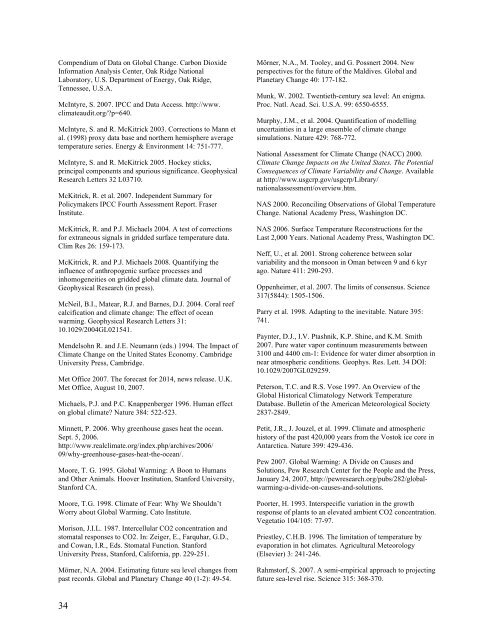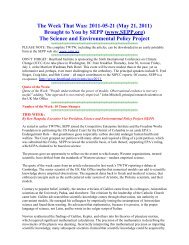Nature, Not Human Activity, Rules the Climate - Science ...
Nature, Not Human Activity, Rules the Climate - Science ...
Nature, Not Human Activity, Rules the Climate - Science ...
You also want an ePaper? Increase the reach of your titles
YUMPU automatically turns print PDFs into web optimized ePapers that Google loves.
Compendium of Data on Global Change. Carbon DioxideInformation Analysis Center, Oak Ridge NationalLaboratory, U.S. Department of Energy, Oak Ridge,Tennessee, U.S.A.McIntyre, S. 2007. IPCC and Data Access. http://www.climateaudit.org/?p=640.McIntyre, S. and R. McKitrick 2003. Corrections to Mann etal. (1998) proxy data base and nor<strong>the</strong>rn hemisphere averagetemperature series. Energy & Environment 14: 751-777.McIntyre, S. and R. McKitrick 2005. Hockey sticks,principal components and spurious significance. GeophysicalResearch Letters 32 L03710.McKitrick, R. et al. 2007. Independent Summary forPolicymakers IPCC Fourth Assessment Report. FraserInstitute.McKitrick, R. and P.J. Michaels 2004. A test of correctionsfor extraneous signals in gridded surface temperature data.Clim Res 26: 159-173.McKitrick, R. and P.J. Michaels 2008. Quantifying <strong>the</strong>influence of anthropogenic surface processes andinhomogeneities on gridded global climate data. Journal ofGeophysical Research (in press).McNeil, B.I., Matear, R.J. and Barnes, D.J. 2004. Coral reefcalcification and climate change: The effect of oceanwarming. Geophysical Research Letters 31:10.1029/2004GL021541.Mendelsohn R. and J.E. Neumann (eds.) 1994. The Impact of<strong>Climate</strong> Change on <strong>the</strong> United States Economy. CambridgeUniversity Press, Cambridge.Met Office 2007. The forecast for 2014, news release. U.K.Met Office, August 10, 2007.Michaels, P.J. and P.C. Knappenberger 1996. <strong>Human</strong> effecton global climate? <strong>Nature</strong> 384: 522-523.Minnett, P. 2006. Why greenhouse gases heat <strong>the</strong> ocean.Sept. 5, 2006.http://www.realclimate.org/index.php/archives/2006/09/why-greenhouse-gases-heat-<strong>the</strong>-ocean/.Moore, T. G. 1995. Global Warming: A Boon to <strong>Human</strong>sand O<strong>the</strong>r Animals. Hoover Institution, Stanford University,Stanford CA.Moore, T.G. 1998. <strong>Climate</strong> of Fear: Why We Shouldn’tWorry about Global Warming. Cato Institute.Morison, J.I.L. 1987. Intercellular CO2 concentration andstomatal responses to CO2. In: Zeiger, E., Farquhar, G.D.,and Cowan, I.R., Eds. Stomatal Function. StanfordUniversity Press, Stanford, California, pp. 229-251.Mörner, N.A. 2004. Estimating future sea level changes frompast records. Global and Planetary Change 40 (1-2): 49-54.Mörner, N.A., M. Tooley, and G. Possnert 2004. Newperspectives for <strong>the</strong> future of <strong>the</strong> Maldives. Global andPlanetary Change 40: 177-182.Munk, W. 2002. Twentieth-century sea level: An enigma.Proc. Natl. Acad. Sci. U.S.A. 99: 6550-6555.Murphy, J.M., et al. 2004. Quantification of modellinguncertainties in a large ensemble of climate changesimulations. <strong>Nature</strong> 429: 768-772.National Assessment for <strong>Climate</strong> Change (NACC) 2000.<strong>Climate</strong> Change Impacts on <strong>the</strong> United States. The PotentialConsequences of <strong>Climate</strong> Variability and Change. Availableat http://www.usgcrp.gov/usgcrp/Library/nationalassessment/overview.htm.NAS 2000. Reconciling Observations of Global TemperatureChange. National Academy Press, Washington DC.NAS 2006. Surface Temperature Reconstructions for <strong>the</strong>Last 2,000 Years. National Academy Press, Washington DC.Neff, U., et al. 2001. Strong coherence between solarvariability and <strong>the</strong> monsoon in Oman between 9 and 6 kyrago. <strong>Nature</strong> 411: 290-293.Oppenheimer, et al. 2007. The limits of consensus. <strong>Science</strong>317(5844): 1505-1506.Parry et al. 1998. Adapting to <strong>the</strong> inevitable. <strong>Nature</strong> 395:741.Paynter, D.J., I.V. Ptashnik, K.P. Shine, and K.M. Smith2007. Pure water vapor continuum measurements between3100 and 4400 cm-1: Evidence for water dimer absorption innear atmospheric conditions. Geophys. Res. Lett. 34 DOI:10.1029/2007GL029259.Peterson, T.C. and R.S. Vose 1997. An Overview of <strong>the</strong>Global Historical Climatology Network TemperatureDatabase. Bulletin of <strong>the</strong> American Meteorological Society2837-2849.Petit, J.R., J. Jouzel, et al. 1999. <strong>Climate</strong> and atmospherichistory of <strong>the</strong> past 420,000 years from <strong>the</strong> Vostok ice core inAntarctica. <strong>Nature</strong> 399: 429-436.Pew 2007. Global Warming: A Divide on Causes andSolutions, Pew Research Center for <strong>the</strong> People and <strong>the</strong> Press,January 24, 2007, http://pewresearch.org/pubs/282/globalwarming-a-divide-on-causes-and-solutions.Poorter, H. 1993. Interspecific variation in <strong>the</strong> growthresponse of plants to an elevated ambient CO2 concentration.Vegetatio 104/105: 77-97.Priestley, C.H.B. 1996. The limitation of temperature byevaporation in hot climates. Agricultural Meteorology(Elsevier) 3: 241-246.Rahmstorf, S. 2007. A semi-empirical approach to projectingfuture sea-level rise. <strong>Science</strong> 315: 368-370.34





